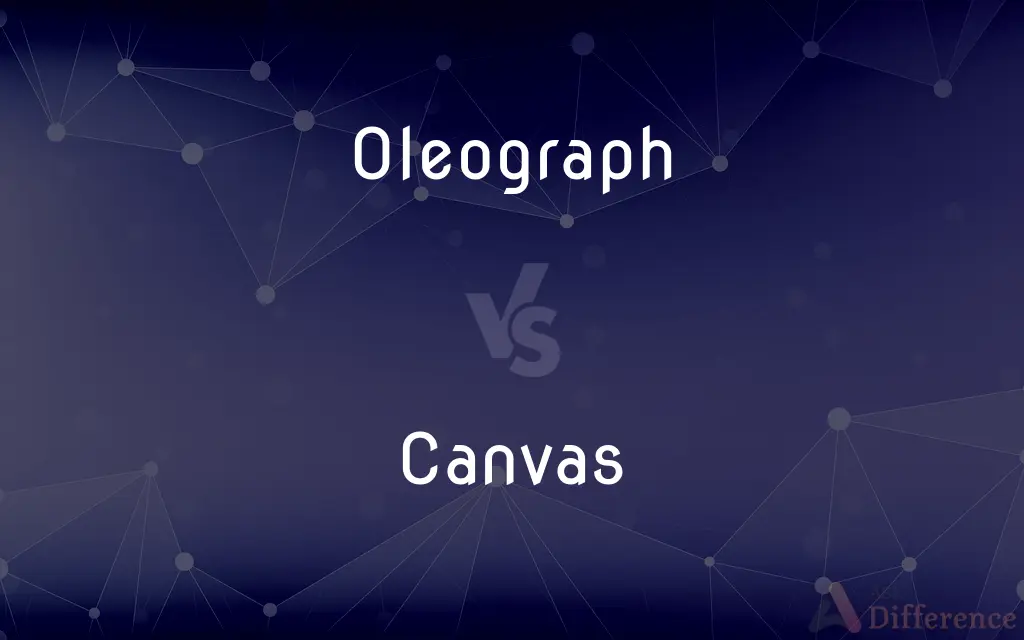Oleograph vs. Canvas — What's the Difference?
By Maham Liaqat & Fiza Rafique — Updated on May 16, 2024
An oleograph is a type of chromolithograph resembling an oil painting, while a canvas is a sturdy fabric used as a surface for painting, especially in oil or acrylic painting.

Difference Between Oleograph and Canvas
Table of Contents
ADVERTISEMENT
Key Differences
An oleograph, also known as an oil print, is a type of print that mimics the appearance of an oil painting. Created using chromolithography, oleographs are produced by printing multiple layers of colored ink on paper to achieve a textured, oil-paint-like finish. Canvas, on the other hand, is a heavy-duty fabric made from materials like cotton or linen, traditionally used as a surface for painting. Artists stretch the canvas over a wooden frame and prime it to create a smooth, stable surface.
Oleographs are prints and thus are typically used for mass-produced artwork, making them accessible and economical. In contrast, canvases are used for original works of art, providing a unique and custom surface for each piece, which can vary in texture and size based on the artist's preferences.
The oleograph’s main appeal lies in its ability to imitate the look of an oil painting at a fraction of the cost, often used for decorative purposes. Canvas, however, is valued for its versatility and ability to support a wide range of artistic techniques and styles, from detailed realism to abstract expressionism.
Oleographs were historically significant for making art accessible to a broader audience during the Victorian era. Canvas remains a staple in the art world, essential for creating both classical and contemporary artworks.
Comparison Chart
Definition
Print resembling an oil painting
Fabric surface used for painting
ADVERTISEMENT
Production Method
Chromolithography
Stretched and primed fabric
Usage
Mass-produced art
Original artworks
Cost
Affordable
Varies, often higher
Historical Significance
Popular in the 19th century
Long-standing use in art
Texture
Imitates oil painting
Natural fabric texture
Durability
Paper-based, less durable
Sturdy and long-lasting
Artistic Techniques
Reproduction
Supports various techniques
Compare with Definitions
Oleograph
Typically made on paper.
The oleograph showed signs of wear due to its paper base.
Canvas
A durable fabric used as a painting surface.
The artist stretched a new canvas before beginning her oil painting.
Oleograph
Affordable alternative to original paintings.
Collectors sometimes prefer oleographs for their historical value.
Canvas
Made from cotton, linen, or synthetic fibers.
High-quality linen canvas is prized for its longevity.
Oleograph
Created using chromolithography to layer colors.
Victorian homes often featured oleographs for affordable decoration.
Canvas
Primed to create a suitable surface for painting.
The canvas was coated with gesso to prepare it for acrylic paints.
Oleograph
Often used for decorative purposes.
Oleographs were a popular way to display famous artworks.
Canvas
Commonly used for oil and acrylic paintings.
The gallery displayed a series of landscapes on canvas.
Oleograph
A print that imitates the appearance of an oil painting.
The oleograph on the wall looked like a genuine oil painting.
Canvas
Canvas is an extremely durable plain-woven fabric used for making sails, tents, marquees, backpacks, shelters, as a support for oil painting and for other items for which sturdiness is required, as well as in such fashion objects as handbags, electronic device cases, and shoes. It is also popularly used by artists as a painting surface, typically stretched across a wooden frame.
Oleograph
A chromolithograph printed with oil paint on canvas in imitation of an oil painting.
Canvas
A strong, coarse unbleached cloth made from hemp, flax, or a similar yarn, used to make items such as sails and tents and as a surface for oil painting
The painting is oil on canvas
A canvas bag
Oleograph
(arts) A type of chromolithograph, using oil paint on canvas, that attempts to imitate oil painting
Canvas
Cover with canvas
The door had been canvassed over
Oleograph
The form or figure assumed by a drop of oil when placed upon water or some other liquid with which it does not mix.
Canvas
A heavy, coarse, closely woven fabric of cotton, hemp, or flax, traditionally used for tents and sails.
Oleograph
A picture produced in oils by a process analogous to that of lithographic printing.
Canvas
A piece of such fabric on which a painting, especially an oil painting, is executed.
Canvas
A painting executed on such fabric.
Canvas
A fabric of coarse open weave, used as a foundation for needlework.
Canvas
The background against which events unfold, as in a historical narrative
A grim portrait of despair against the bright canvas of the postwar economy.
Canvas
(Nautical) A sail or set of sails.
Canvas
A tent or group of tents.
Canvas
A circus tent.
Canvas
(Sports) The floor of a ring in which boxing or wrestling takes place.
Canvas
A type of coarse cloth, woven from hemp, useful for making sails and tents or as a surface for paintings.
Canvas
(painting)
Canvas
A piece of canvas cloth stretched across a frame on which one may paint.
Canvas
A painting, or a picture on canvas.
Canvas
A mesh of loosely woven cotton strands or molded plastic to be decorated with needlepoint, cross-stitch, rug hooking, or other crafts.
Canvas
(figuratively) A basis for creative work.
The author takes rural midwestern life as a canvas for a series of tightly woven character studies
Canvas
(computer graphics) A region on which graphics can be rendered.
Canvas
(nautical) Sails in general.
Canvas
A tent.
He spent the night under canvas.
Canvas
A rough draft or model of a song, air, or other literary or musical composition; especially one to show a poet the measure of the verses he is to make.
Canvas
(Nigeria) Athletic shoes.
Canvas
Obsolete spelling of canvass
Canvas
(transitive) To cover (an area or object) with canvas.
Canvas
Obsolete spelling of canvass
Canvas
A strong cloth made of hemp, flax, or cotton; - used for tents, sails, etc.
By glimmering lanes and walls of canvas led.
Canvas
A coarse cloth so woven as to form regular meshes for working with the needle, as in tapestry, or worsted work.
History . . . does not bring out clearly upon the canvas the details which were familiar.
Canvas
Something for which canvas is used: (a) A sail, or a collection of sails. (b) A tent, or a collection of tents. (c) A painting, or a picture on canvas.
To suit his canvas to the roughness of the see.
Light, rich as that which glows on the canvas of Claude.
Canvas
A rough draft or model of a song, air, or other literary or musical composition; esp. one to show a poet the measure of the verses he is to make.
Canvas
Made of, pertaining to, or resembling, canvas or coarse cloth; as, a canvas tent.
Canvas
Heavy closely woven fabric (used for clothing or chairs or sails or tents)
Canvas
An oil painting on canvas
Canvas
The setting for a narrative or fictional or dramatic account;
The crowded canvas of history
The movie demanded a dramatic canvas of sound
Canvas
A tent made of canvas
Canvas
A large piece of fabric (as canvas) by means of which wind is used to propel a sailing vessel
Canvas
The mat that forms the floor of the ring in which boxers or professional wrestlers compete;
The boxer picked himself up off the canvas
Canvas
Solicit votes from potential voters in an electoral campaign
Canvas
Get the opinions (of people) by asking specific questions
Canvas
Cover with canvas;
She canvassed the walls of her living room so as to conceal the ugly cracks
Canvas
Consider in detail and subject to an analysis in order to discover essential features or meaning;
Analyze a sonnet by Shakespeare
Analyze the evidence in a criminal trial
Analyze your real motives
Canvas
Provides a textured surface that holds paint well.
The canvas texture added depth to the abstract artwork.
Common Curiosities
How is an oleograph made?
An oleograph is made by layering multiple colors of ink on paper through a process called chromolithography.
Why were oleographs popular in the 19th century?
Oleographs were popular because they provided an affordable alternative to original oil paintings.
How durable are oleographs compared to canvas paintings?
Oleographs, being paper-based, are generally less durable than canvas paintings, which are made from sturdy fabric.
What materials are canvases made from?
Canvases are typically made from cotton, linen, or synthetic fibers.
What is a canvas used for?
Canvas is used as a surface for painting, particularly for oil and acrylic paints.
Are oleographs still produced today?
While not as common, oleographs are still produced and collected for their historical and decorative value.
Can you paint directly on canvas?
Yes, but canvases are usually primed with a substance like gesso to create a smooth, stable surface for painting.
What is an oleograph?
An oleograph is a type of print that mimics the look of an oil painting, created using chromolithography.
Why do artists prefer canvas for painting?
Artists prefer canvas because of its durability, texture, and ability to support various painting techniques.
Is there a cost difference between oleographs and canvas paintings?
Yes, oleographs are generally more affordable than original canvas paintings due to their mass-produced nature.
What makes oleographs different from original oil paintings?
Oleographs are mass-produced prints, whereas original oil paintings are unique works of art created by hand.
What is the primary use of canvas in art?
Canvas is primarily used as a surface for painting in mediums like oil and acrylic.
Do oleographs have any texture?
Oleographs mimic the texture of oil paintings but are relatively flat compared to actual brushstrokes on canvas.
Can canvas be used for any other purposes besides painting?
Yes, canvas can also be used for creating bags, sails, and tents due to its durability.
What is the significance of priming a canvas?
Priming a canvas prepares the surface, ensuring that the paint adheres properly and prevents deterioration over time.
Share Your Discovery

Previous Comparison
Skysurfing vs. Skydiving
Next Comparison
Symbol vs. LegendAuthor Spotlight
Written by
Maham LiaqatCo-written by
Fiza RafiqueFiza Rafique is a skilled content writer at AskDifference.com, where she meticulously refines and enhances written pieces. Drawing from her vast editorial expertise, Fiza ensures clarity, accuracy, and precision in every article. Passionate about language, she continually seeks to elevate the quality of content for readers worldwide.
















































